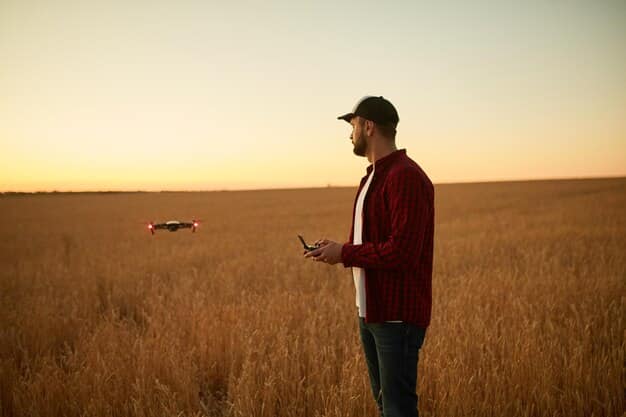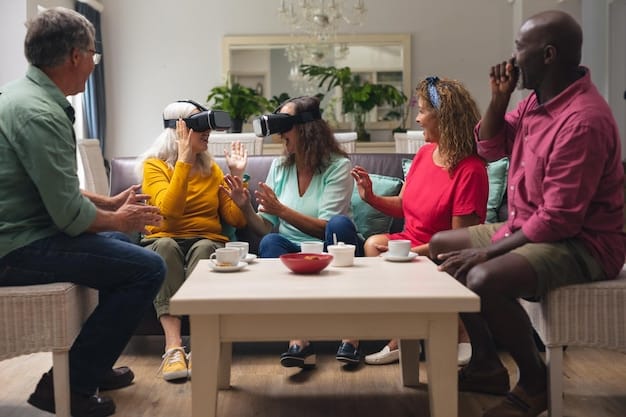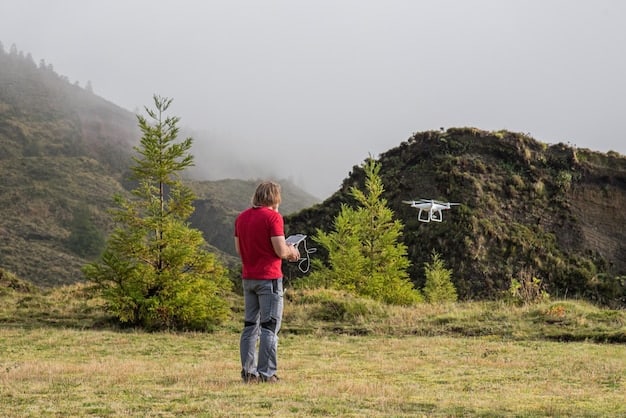Drones for Beginners: Your Step-by-Step Guide to Getting Started

Navigating the world of drones for beginners involves understanding basic concepts like flight mechanics, safety regulations, and choosing the right model, ensuring a smooth and enjoyable entry into this evolving technology.
Embarking on the journey of owning and flying a drone can feel both exhilarating and daunting. For those eager to explore the skies, a clear, step-by-step approach is crucial to ensure safety, enjoyment, and skill development. This guide is designed to provide you with everything you need to know about Drones for Beginners: A Step-by-Step Guide to Getting Started, from understanding the basics to mastering advanced maneuvers.
Understanding the Basics: What is a Drone and How Does it Fly?
Before taking to the skies, it’s essential to grasp the fundamental nature of what a drone is and the principles governing its flight. Often referred to as Unmanned Aerial Vehicles (UAVs), drones are aircraft without a human pilot aboard, controlled remotely or flying autonomously based on pre-programmed flight plans.
These devices typically rely on multiple propellers, usually four (quadcopters), six (hexacopters), or eight (octocopters), to generate lift and thrust. The individual speed of each motor can be precisely controlled, allowing the drone to move in any direction: ascent, descent, hover, and horizontal movement. This intricate ballet of propulsion is managed by an onboard flight controller, which interprets commands from the pilot’s remote control or autonomous instructions.
Key Components of a Beginner Drone
A typical drone for beginners will include several core components that work in harmony to enable flight and operation. Understanding these parts demystifies how the drone functions and assists in troubleshooting or maintenance.
- Frame: The structural backbone of the drone, housing all components and providing durability.
- Motors: Electric motors that rotate the propellers. Brushless motors are common in hobby drones for efficiency and power.
- Propellers: Blades designed to create lift by pushing air downwards. Different sizes and pitches affect flight characteristics.
- Flight Controller: The “brain” of the drone, interpreting commands, stabilizing flight, and running autonomous functions.
- Battery: Powers the motors, flight controller, and any onboard electronics. Lithium Polymer (LiPo) batteries are standard due to their high power-to-weight ratio.
- Remote Controller (Transmitter): The device used by the pilot to send commands to the drone.
Beyond these, many modern drones incorporate GPS modules for stable hovering and return-to-home functions, cameras for aerial photography and videography, and various sensors for obstacle avoidance. For beginners, understanding these components is the first step towards a confident and informed flight experience.
The synergy of these components allows a drone to defy gravity and perform complex maneuvers, making them versatile tools for recreational flying, aerial photography, and even commercial applications. Familiarizing yourself with these basics will greatly enhance your learning curve.
Choosing Your First Drone: Factors to Consider for Beginners
Selecting your initial drone can feel overwhelming given the vast array of options available. For beginners, the key is to prioritize ease of use, durability, and a reasonable price point. Avoid expensive, complex models until you’ve gained experience.
When starting, look for drones marketed specifically as “beginner” or “training” models. These often come with features designed to simplify the learning process, such as altitude hold, one-key take-off/landing, and headles mode, which eliminates the need to orient the drone. These features help new pilots focus on basic control without worrying about complex maneuvers.
Deciding on Your Usage
Your primary intended use for the drone will significantly influence your choice. Are you looking for a recreational toy, a device to practice aerial photography, or simply to get a feel for drone flying?
- Recreational Flying: Small, inexpensive mini-drones or toy drones are perfect for indoor practice and basic outdoor flights. They are durable enough to withstand crashes and often don’t require FAA registration.
- Aerial Photography/Videography: If capturing stunning visuals is your goal, look for drones with integrated cameras. For beginners, models that offer stable flight and basic HD recording are ideal. Advanced features like gimbal stabilization and 4K recording typically come with a higher price tag and steeper learning curve.
- Learning Controls: Some drones are specifically designed as trainers, focusing purely on flight mechanics without added complexities. These are excellent for developing fundamental piloting skills.
Consider the environment you’ll be flying in most frequently. Smaller drones are suitable for indoor use and calm outdoor conditions, while larger models handle wind better but require more open space.

Also, research battery life and charging times. Shorter flight times mean more frequent charging, which can interrupt your practice sessions. Look for models with swappable batteries to extend your flying time. Customer reviews and online forums can also be invaluable resources for real-world insights into a particular drone’s performance and reliability.
Understanding Drone Regulations and Safety: Flying Responsibly
Before launching your drone, it is paramount to understand and adhere to local and national regulations. In the United States, the Federal Aviation Administration (FAA) governs drone operations, and non-compliance can lead to significant penalties. Responsible flying is not just about avoiding legal issues; it’s about ensuring the safety of people and property.
For recreational flyers, the FAA requires registration of drones weighing 0.55 pounds (250 grams) or more. This registration is a simple online process, and you must mark your drone with your registration number. Additionally, flyers must pass “The Recreational UAS Safety Test” (TRUST) administered by FAA-approved test administrators. This test ensures you understand key safety guidelines.
Key Regulatory Guidelines for Recreational Flyers
Adhering to these general rules is crucial for safe and legal drone operation:
- Fly below 400 feet: Maintain your drone at or below 400 feet above ground level to avoid conflicts with manned aircraft.
- Keep your drone within sight: Always maintain visual line of sight with your drone. This means you must be able to see it with your own eyes without the aid of binoculars or other vision-enhancing devices.
- Do not fly over people: Avoid flying directly over unprotected people unless they are part of the operation.
- Do not fly over moving vehicles: Never operate your drone over moving vehicles.
- Do not interfere with emergency response activities: Give way to all manned aircraft and do not fly near emergency sites.
- Respect privacy: Be mindful of individuals’ privacy when operating your drone.
- Check airspace restrictions: Use apps like B4UFLY to identify any airspace restrictions in your intended flying area. This includes temporary flight restrictions (TFRs) and permanent restrictions around airports, military bases, and critical infrastructure.
These regulations are for the safety of everyone, including yourself and your drone. Taking the time to study and understand them will prevent potential accidents and legal issues. Always prioritize safety over convenience or aerial shots.
Understanding these rules is not merely bureaucratic; it’s the foundation for a positive and safe drone piloting experience. Ignorance of the law is never an excuse, and investing the time to learn these guidelines will protect you and others.
Pre-Flight Checks and Your First Flight: A Step-by-Step Approach
Before every flight, a thorough pre-flight check is indispensable. This routine minimizes the risk of accidents caused by equipment malfunction or oversight. Just like a pilot checks their aircraft, you should inspect your drone and prepare your flying environment.
Start by checking the drone’s physical condition: ensure propellers are securely attached and free from cracks, the battery is fully charged and properly installed, and all connections are snug. Inspect the remote controller battery levels and ensure it’s properly calibrated and linked to the drone. Always carry spare propellers and a fully charged backup battery if possible.
Steps for a Successful First Flight
When you’re ready to take off, choose an open area away from people, buildings, trees, and power lines. A large, empty field or park without dense foliage is ideal. Ensure weather conditions are calm, with minimal wind, especially for your initial flights.
- Power On: Turn on your remote controller first, then your drone. Wait for both to establish a connection and for the drone’s GPS (if equipped) to acquire satellites.
- Calibrate (if needed): Some drones require compass calibration before each flight, especially if you’ve moved locations significantly. Follow your drone’s specific instructions for this.
- Arm Motors: Most drones require a specific stick combination on the controller to enable the motors. Consult your user manual.
- Gentle Take-off: Slowly increase the throttle. The drone should lift off smoothly and hover. Practice hovering a few feet off the ground, getting a feel for the controls.
- Basic Maneuvers: Once comfortable hovering, practice simple movements: forward, backward, left, right, and rotating. Keep movements small and controlled.
- Landing: Practice gentle landings. Decrease the throttle slowly until the drone touches down softly. Disarm the motors immediately after landing.
Remember that practice is key. Your first flights should be short and focused on gaining muscle memory and confidence. Don’t attempt complex maneuvers early on. Patience and consistency will lead to proficiency.
Each successful flight, no matter how brief, builds confidence and familiarizes you with your drone’s specific handling characteristics. Documenting your flights, perhaps in a simple log, can also help track your progress and identify areas for improvement.
Mastering Controls and Advanced Maneuvers: Beyond the Basics
Once you are comfortable with basic take-offs, hovering, and simple movements, it’s time to expand your piloting repertoire. Mastering controls involves precise input and understanding how your drone responds to different stick movements. This stage focuses on refining your control and introducing more dynamic flight patterns.
Practice smooth, continuous movements rather than jerky adjustments. Work on controlled ascents and descents, maintaining a consistent climb rate or descent rate. Incorporate turns, both wide and tight, keeping the drone’s orientation in mind. The goal is to make the drone an extension of your will.
Exploring Advanced Flight Techniques
As your confidence grows, you can start experimenting with more complex maneuvers. Always ensure you have sufficient space and clear skies before attempting these.
- Figure Eights: Flying in figure-eight patterns helps improve coordination between throttle, yaw (rotation), and pitch (forward/backward movement).
- Orbiting: Learn to fly your drone in a perfect circle around a stationary object or person. This requires precise control of yaw and sideways movement.
- “Touch and Go”: Practice landing briefly and immediately taking off again. This refines your landing accuracy and quick transition skills.
- Obstacle Course: Set up a simple obstacle course using cones or flags to navigate around. This enhances agility and spatial awareness.
Many modern drones offer flight modes designed to assist with these maneuvers, such as “Sport Mode” for faster, more agile flight, or “Cinematic Mode” for smoother, slower movements ideal for video recording. Experiment with these modes as you gain proficiency.

Beyond manual controls, delve into autonomous flight modes if your drone supports them. Features like Waypoints, ActiveTrack (for following subjects), and Point of Interest (for orbiting a target) can open new creative possibilities and offer a different perspective on flight. However, always be prepared to take manual control if an automated function encounters an issue. Consistent practice is the cornerstone of mastery.
Maintenance and Troubleshooting: Keeping Your Drone in Top Condition
Proper maintenance is crucial for the longevity and safety of your drone. Just like any sophisticated piece of equipment, drones require routine checks and occasional troubleshooting to ensure optimal performance. Neglecting maintenance can lead to unexpected malfunctions and potentially costly repairs.
After each flight, particularly if you’ve flown in challenging conditions (dusty, sandy, or damp environments), take a few moments to inspect your drone. Look for signs of wear and tear, paying close attention to the propellers, motors, and battery. A clean drone is often a happy drone, so gently wipe down surfaces to remove dirt and debris.
Common Issues and How to Address Them
- Damaged Propellers: The most common issue. Always replace bent, chipped, or cracked propellers immediately. Keeping spares is essential. Unevenly worn propellers can cause vibrations and unstable flight.
- Battery Issues: If your battery isn’t charging or is losing charge quickly, it might be nearing the end of its life cycle. Ensure you’re using the correct charger and following battery care guidelines (e.g., storing at a moderate charge level).
- Unstable Flight/Drifting: This often indicates a need for calibration (compass or IMU), or possibly damaged motors or unbalanced propellers. Refer to your drone’s manual for calibration procedures.
- Loss of Signal: Ensure your remote controller batteries are charged and that you are within the drone’s operational range. Avoid areas with high electromagnetic interference.
- Firmware Updates: Drones often receive firmware updates that improve performance, add features, or fix bugs. Regularly check for and install these updates to keep your drone current and functioning correctly.
If you encounter persistent issues that you cannot resolve, consult your drone’s user manual, manufacturer’s online support, or relevant drone communities and forums. Often, another drone pilot has encountered and solved a similar problem.
Regular, proactive maintenance not only extends your drone’s lifespan but also ensures a safer and more enjoyable flying experience. A well-maintained drone is a reliable drone, ready for adventures at a moment’s notice.
Expanding Your Drone Horizons: Photography, Video, and Beyond
Once you’ve mastered the fundamentals of flight, the world of drone applications truly opens up. Many beginners are drawn to drones for their incredible aerial photography and videography capabilities, but the potential extends far beyond creating stunning visuals. Exploring these advanced uses can significantly enrich your drone experience.
For those interested in visual media, understanding camera settings, composition, and flight paths designed for smooth footage is key. Experiment with different altitudes and angles. Learning basic video editing software can transform raw footage into captivating cinematic sequences, adding music and transitions to tell a story from the sky.
Creative and Practical Applications
- Aerial Photography & Videography: This is arguably the most popular advanced application. Drones provide unique perspectives for landscapes, real estate, events, and personal projects. Focus on smooth movements, good lighting, and thoughtful composition.
- FPV (First Person View) Racing: For the adrenaline seekers, FPV drones offer an immersive piloting experience through goggles, putting you virtually in the cockpit. This niche requires significant practice and specialized equipment but provides unparalleled speed and agility.
- Mapping and Surveying: Drones equipped with specialized cameras and software can generate detailed 2D maps and 3D models of terrain and structures, valuable for construction, agriculture, and environmental monitoring.
- Search and Rescue: Drones can assist in locating missing persons in difficult-to-reach areas, especially when equipped with thermal cameras.
- Educational Projects: Integrating drones into STEM education can provide hands-on learning experiences in physics, engineering, and computer science.
Each of these avenues requires further learning and often specific equipment. Whether you delve into the artistic side of aerial cinematography or the technical realm of FPV racing, the drone community is vast and welcoming, offering resources and support for every interest.
The journey from a beginner pilot to an advanced enthusiast or professional is continuous, filled with new challenges and opportunities. Embracing continuous learning and experimentation will keep your drone experience fresh and exciting, revealing the true versatility of these incredible machines.
| Key Point | Brief Description |
|---|---|
| 🚀 Choose Wisely | Start with beginner-friendly, durable models; avoid complex ones early on. |
| 📜 Know the Rules | Understand FAA regulations, register if needed, and pass the TRUST test. |
| ✈️ Practice Safely | Master basic controls in open spaces before attempting advanced maneuvers. |
| 🔧 Maintain Regularly | Perform pre-flight checks and address issues like damaged propellers promptly. |
Frequently asked questions
▼
For beginners, models like the Holy Stone HS110D, DJI Mini 2 SE, or Ryze Tello are often recommended. They offer a good balance of durability, ease of use, and essential features such as altitude hold and headless mode, making learning less intimidating and more enjoyable for new pilots exploring drone piloting.
▼
If your drone weighs 0.55 pounds (250 grams) or more, you must register it with the FAA before flying outdoors. This applies to recreational flyers. Additionally, you need to pass “The Recreational UAS Safety Test” (TRUST) to demonstrate understanding of drone safety rules and regulations.
▼
Most consumer drone batteries last between 15 to 30 minutes, depending on the model and flying conditions. To extend flight time, consider purchasing multiple spare batteries. Proper battery care, like storing them at recommended charge levels and avoiding extreme temperatures, also helps prolong their lifespan and performance.
▼
Always maintain visual line of sight with your drone, fly below 400 feet, and avoid flying over people or moving vehicles. Check airspace restrictions using apps like B4UFLY before each flight. Never fly near airports or emergency response scenes, and always respect privacy.
▼
Yes, smaller and lighter drones are often suitable for indoor flying, especially for beginners to practice controls in a controlled environment. Ensure you have enough clear space to avoid obstacles, and always check your drone’s manual for specific recommendations on indoor operation regarding GPS or other sensor requirements.
Conclusion
Embarking on the drone journey as a beginner is an exciting endeavor that promises both fun and a unique perspective on the world. By diligently following this step-by-step guide—from understanding the fundamental mechanics and choosing the right entry-level model to adhering to vital safety regulations and mastering flight controls—you are well-equipped for a positive and rewarding experience. Remember, consistent practice, responsible flying, and an openness to continuous learning are the cornerstones of becoming a proficient drone pilot. The skies await your exploration, offering endless possibilities for recreation, creativity, and practical utility.





